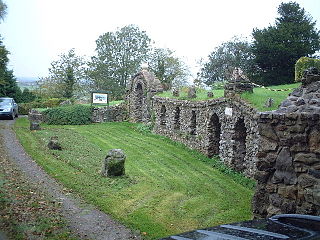
Mammoth Cave National Park is an American national park in central Kentucky, encompassing portions of Mammoth Cave, the longest cave system known in the world. Since the 1972 unification of Mammoth Cave with the even-longer system under Flint Ridge to the north, the official name of the system has been the Mammoth–Flint Ridge Cave System. The park was established as a national park on July 1, 1941, a World Heritage Site on October 27, 1981, and an international Biosphere Reserve on September 26, 1990.

Cave Hill Cemetery is a 296-acre (1.20 km2) Victorian era National Cemetery and arboretum located at 701 Baxter Avenue, Louisville, Kentucky, United States. Its main entrance is on Baxter Avenue and there is a secondary one on Grinstead Drive. It is the largest cemetery by area and number of burials in Louisville.

The Divje Babe Flute is a cave bear femur pierced by spaced holes that was found in 1995 at the Divje Babe archeological park located near Cerkno in northwestern Slovenia. It has been suggested that it was made by Neanderthals as a form of musical instrument, its hole spacing and alignment leading to its being labeled a "Neanderthal flute." Slovenian archeologist Mitja Brodar, however, argues that it was made by Cro-Magnons as an element of Central European Aurignacian culture. Despite alternative hypotheses suggesting it was formed by animals, the artifact remains on prominent public display in the National Museum of Slovenia in Ljubljana as a Neanderthal flute. As such, it is possibly the world's oldest known musical instrument.

Carter Caves State Resort Park is located in Carter County, Kentucky, United States, along Tygarts Creek. It is formed by Carter Caves, and nearby Cascade Caves, which were added to the park in 1959. On December 16, 1981, 146 acres (59 ha) of the park were designated as nature preserves. Bat Cave and Cascade Caverns State Nature Preserves were dedicated for the protection of the Indiana bat, mountain maple, and Canada yew, all endangered species.

(Big) Bone Cave is a cave located in Van Buren County, Tennessee, in the community of Bone Cave that is named after it. It is notable both for its history and current recreational use. It is listed on the National Register of Historic Places and a designated National Natural Landmark. It is a 400-acre (161.9 ha) State Natural Area managed by Rock Island State Park. It is named for the discovery of the bones of a giant ground sloth in 1811. The cave was operated as a saltpeter mine, notably during the War of 1812 and the American Civil War. A variety of natural remains and human artifacts have been well preserved in the dry atmosphere of the cave. The cave is the 10th longest mapped cave in Tennessee.

Banwell Caves are a 1.7-hectare geological and biological Site of Special Scientific Interest near the village of Banwell, North Somerset, England notified in 1963.
The Pinza-Abu Cave Man is a prehistoric people known from bones found in the Pinza-Abu Cave, near Ueno in Miyako Island, southern Japan. The remains appear to have the modern man anatomical type and have been dated to about 30,000 years ago, i.e. 25,800 ± 900 and 26,800 ± 1,300 before present. The name "Pinza-Abu" literally means "goat cave" in the local Miyako language.

Yuchanyan is an early Neolithic cave site in Dao County (Daoxian), Hunan, China. The site yielded sherds of ceramic vessels and other artifacts which were dated by analysis of charcoal and bone collagen, giving a date range of 17,500 to 18,300 years old for the pottery. The pottery specimens may be the oldest known examples of pottery.
During regular archaeological excavations several flutes, that date to the European Upper Paleolithic have been discovered in caves in the Swabian Alb region of Germany. Dated and tested independently by two laboratories, in England and Germany, the artifacts are authentic products of the Homo sapiens Aurignacian archaeological culture, made in between 43,000 and 35,000 years ago. The flutes, made of bone and ivory, represent the earliest known musical instruments and provide unmistakable evidence of prehistoric music. The flutes were found in the Caves with the oldest Ice Age art, where also the oldest known examples of figurative art were discovered. Music and sculpture as artistic expression have developed simultaneously among the first humans in Europe, as the region is considered a key area in which various cultural innovations have developed. Experts say, besides serving recreation and religious purposes, ritual music might have helped to maintain larger social networks, a competitive advantage over the Neanderthals.

Qesem cave is a Lower Paleolithic archeological site 12 km east of Tel Aviv in Israel. Early humans were occupying the site by 400,000 until c. 200,000 years ago.

Denisova Cave is a cave in the Bashelaksky Range of the Altai mountains, Siberia, Russia. The cave is of great paleoarchaeological and paleontological interest. Bone fragments of the Denisova hominin originate from the cave, including artifacts dated to around 40,000 BP. A 32,000-year-old prehistoric species of horse has also been found in the cave.

Paleontology in Kentucky refers to paleontological research occurring within or conducted by people from the U.S. state of Kentucky. Kentucky's abundance of exposed sedimentary rock makes it an ideal source of fossils. The oldest exposed rocks in Kentucky are of Ordovician age. The geologic column of Kentucky also contains rocks deposited during the ensuing periods until the end of the Pennsylvanian. During this span of time the state was first home to a warm shallow sea home to an abundance and variety of brachiopods, cephalopods, crinoids, and trilobites. During the Devonian, a large reef system formed at what is now the Falls of the Ohio. Swamps covered Kentucky during the ensuing Carboniferous period. Then a gap spans from the start of the Permian to the Pleistocene, although the gap is interrupted by minor deposits of Cretaceous and Eocene rocks. These deposits mainly preserve plant fossils. Ice Age Kentucky was home to short-faced bear, bison, elk, lions, mammoths, mastodons, and giant ground sloths. Local Native Americans interpreted fossils of this age at Big Bone Lick as belonging to ancient monsters killed by benevolent mystical little people. This same fossil deposit would attract attention from major American figures like George Washington, Daniel Boone, and, especially, Thomas Jefferson. Amateur fossil collectors should be aware that they need permission from landowners to prospect legally on private property. Brachiopods are the Kentucky state fossil.

Kutikina Cave is a rock shelter located on the Franklin River in the South West Wilderness, a World Heritage Area in the Australian state of Tasmania.

The Mladeč caves are a cave complex in the Czech Republic situated to the west of the village of Mladeč in the Litovelské Pomoraví Protected Landscape Area.

The Corbeddu cave is located in the territory of Oliena, municipality of the province of Nuoro, in Sardinia. In this cave found refuge the famous Sardinian bandit Giovanni Corbeddu Salis (1844-1898), from which it took its name.

Ōzakai Cave Dwelling is an archaeological site consisting of a cave dwelling in what is now part of the city of Himi, Toyama Prefecture in the Hokuriku region of Japan. The site was designated a National Historic Site of Japan in 1986.

The Schmerling Caves are a group of caves on the right bank of the stream called the Awirs, near the village of Awirs in Flémalle, Belgium. The caves are notable for their past fossil finds, particularly of hominins. They were explored in 1829 by Philippe-Charles Schmerling, who discovered, in the lower cave, the remains of two individuals, one of which, now known as Engis 2, was a fossil of the first Neanderthal ever found; the other was a Neolithic homo sapiens. Also known as Trô Cwaheur or Trou Caheur, this lower cave has since collapsed. A third cave was destroyed because of work on the adjacent quarry, the Ancienne Carrière des Awirs.

The Cave of Salemas is located close to the village of Lousa in the municipality of Loures in the Lisbon District of Portugal. Discovered by archaeologists during the 1950s, the cave appears to have been occupied by humans as a temporary refuge during the Upper Paleolithic and used as a tomb during the Neolithic.


















